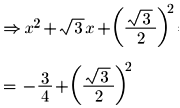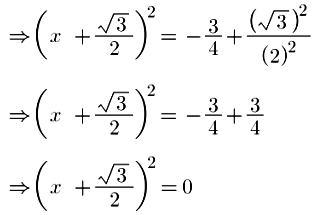Given: The quadratic equation \(4x^2+4\sqrt{3}x+3=0\)
To find: the roots of the following quadratic (if they exist) by the method of completing the square.
Solution: We have to make the quadratic equation a perfect square if possible or sum of perfect square with a constant.
Step 1: Make the coefficient of x2 unity.In the equation \(4x^2+4\sqrt{3}x+3=0,\) The coefficient of x2 is 4.So to make the coffecient of x2 equals to 1.divide the whole equation by 4.
The quadratic equation now becomes:

Step 2: Shift the constant term on RHS,
\(\Rightarrow x^2+\sqrt{3}x=-\frac{3}{4}\)
Step 3: Add square of half of coefficient of x on both the sides.

Step 4: Apply the formula,(a + b)2 = a2 + 2ab + b2 on LHS and solve RHS,
Here a = x and b \(=\frac{\sqrt{3}{}}{2}\)

Step 5: As the RHS is zero, the roots exist.Since the quadratic equations have 2 roots, in this case both roots will be same.
